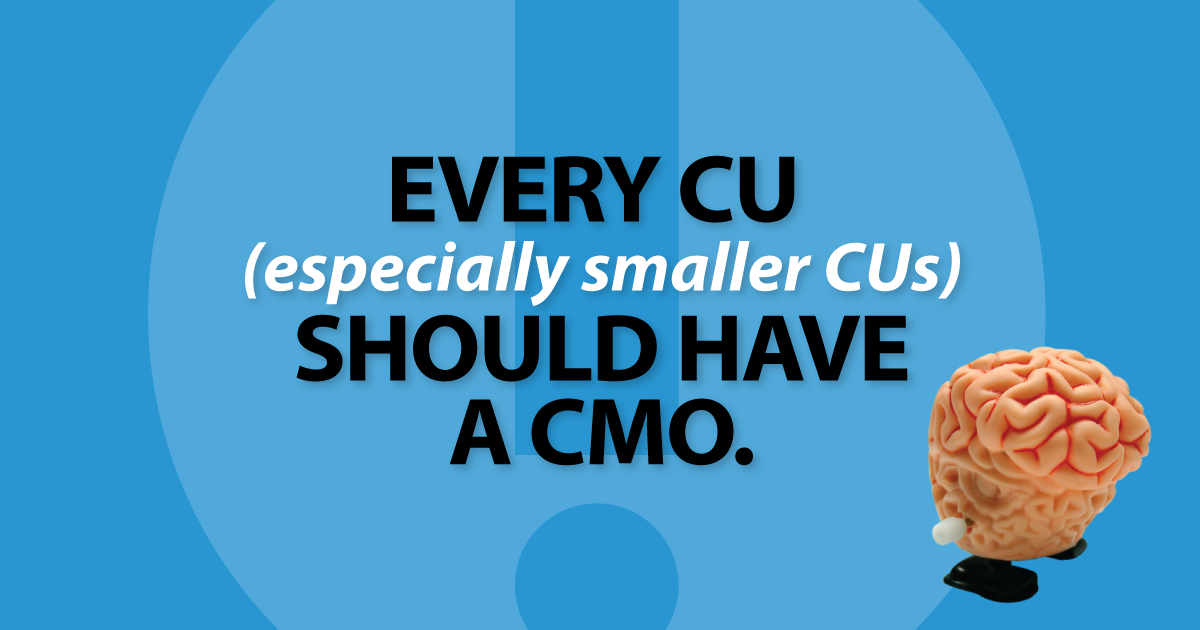
Credit Union CEOs need CMOs ASAP & PDQ
One of the great things about working with credit unions of every size all over the country is that they’re all so different. Every CU has its own interesting culture and unique way of doing things.
And one of those very telling differences is the role of marketing in the organizational chart. What’s the title of the person heading up Marketing?
Are they a CMO? SVP? VP? AVP? Manager? Director? Assistant? And is marketing their only job, or just one of their hats? We’ve seen just about every possibility and combination from every size credit union.
Here’s why we think every CU, even smaller CUs (especially smaller CUs), should have a CMO – a full-time, C-level executive with direct long-term strategic responsibility and authority (AKA budget and clout), who reports to the CEO and Board.
A CMO means you’re serious about growth and transformation
The kind of growth and change credit unions need to survive and thrive in 2025, 2030, 2050 and beyond is not going to “just happen”. It’s a core, long-range strategic imperative, not a quick fix.
Marketing is fundamentally about driving growth and leading brands into the future. It’s a big, complicated, and very long-range function that affects every part of the credit union, and someone with a high level of talent needs to be in charge of that process.
What’s in a title?
Of course, there are other executive titles out there that might work better for you. In some business circles, CMO is even starting to seem outdated.
For example, maybe CXO (Chief Experience Officer), CCO (Chief Culture Officer, Chief Connection Officer), CDO (Chief Digital Officer), CGO (Chief Growth Officer), CBO (Chief Brand Officer) or even something like MHO (Member Happiness Officer) or EICOA (Exec In Charge Of Awesome) works better for your culture.
Whatever the title is, this person needs to have the tools to succeed, not just a title and a seat at the table. They need real clout; support from the other execs, resources, knowledge, training, and broad decision-making abilities. They also need accountability; a clear strategic mandate and goals straight from the Board and CEO.
One Big Hat
Whatever you call your person in charge of Marketing, it’s important to fit them with one big hat, not a collection of hats. The temptation to get a two-fer (or three-fer, or four-fer…) by tacking on facilities management duties or some other unrelated title is way too common, but Marketing is a big job that requires 100% focus.
Dang, sounds expensive…
We’ve worked with credit unions all over the country for a long time. One of the principles we’ve seen play out over and over again is that good marketing, brand, and website work is a good investment, but great marketing is an incredible investment.
Purpose, clarity, vision, strategy, persistence, and resources matter a lot, and marketing quality multiplies results and growth in a non-linear way.
So yes, good investments in marketing are absolutely worth it. That starts with your Chief Marketing Officer.
Your CMO needs resources, but that doesn’t necessarily mean a large cast. We work with a lot of small and medium sized credit unions who find it far more efficient and cost-effective to hire outside resources as needed to help with marketing, brand strategy, websites, and so forth rather than adding staff.
Their one or two person department calls the shots and directs the show, but they make the most of their time and money by leveraging experienced vendors like us. Even at CUs with more in-house staff, we can bring new perspectives and ideas and help everyone become far more efficient and effective.
Take the hat off the CEO’s head
There’s one other important benefit of CMO; it frees up the CEO’s scarce time and attention. Credit Union CEOs need a long-term, long-range strategic focus, but we’ve seen many times that it’s easy for CU CEOs to get mired in managing marketing rather than exercising oversight.
Of course, CU CEOs should be deeply involved in marketing, branding, and in every core CU function, but at the strategic level, not at the everyday management and decision-making level.
Every credit union is different, but one of the things they all have in common is the need to make marketing a growth and transformation engine. Whatever you call the position, it’s a core strategic function that requires C-suite leadership.
This article was also posted on cuinsight.com.
- Why credit union websites must be flexy and stretchy - July 15, 2025
- How to keep your credit union’s website clean and member-focused - July 1, 2025
- Credit union website analytics: mysteries we can’t explain - June 4, 2025
